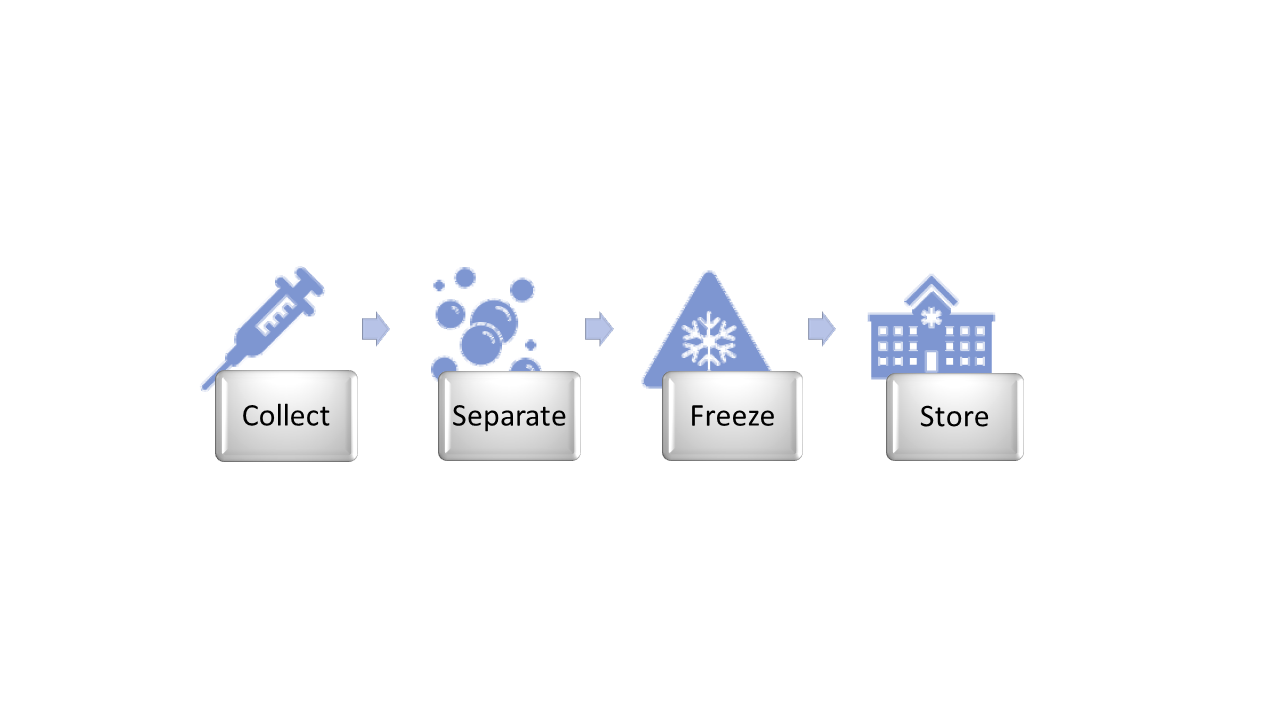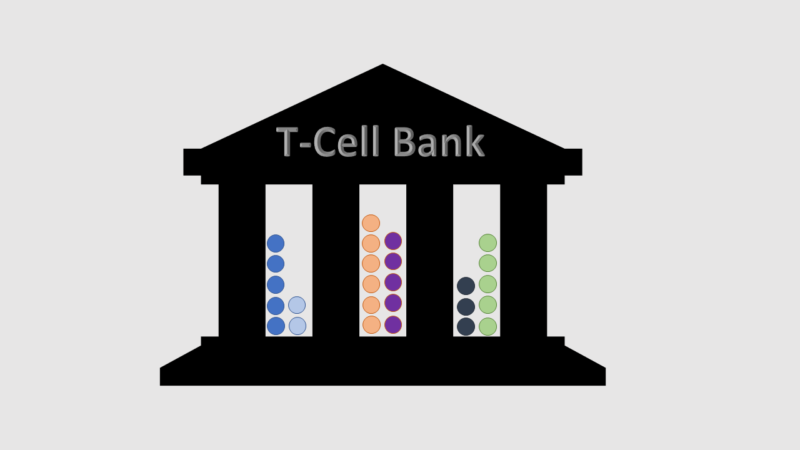As cancer therapies increasingly include using the patient’s own immune cells to fight the cancer, a new product has emerged on the market. Cell Vault is a new company that will send anyone a blood collection kit, draw the blood either at home or in an office, and then store the processed sample frozen in case it is needed later (Figure 1). Like other cryopreservation companies, the storage fee is where the company makes most of the money.

Figure 1. PBMC collection and processing for cryopreservation. Read more
Other cryopreservation and cryobanking services include those for freezing and storing sperm, oocytes (a woman’s eggs), fertilized embryos, and umbilical cord blood cells. With the exception of umbilical cord blood cells, the others are all intended to aid reproduction and are used in cases of infertility. Sometimes the sperm or eggs are intended for donation to infertile couples; sometimes they are intended for personal use by the donor. Only those individuals storing their sperm or eggs for personal use incur a cost; egg and sperm donors are typically paid for donating.
Like umbilical cord blood cells, the cells preserved by Cell Vault are intended for treating disease. Umbilical cord blood cells are valuable because they include hematopoietic stem cells, which are the stem cells that can regenerate all types of cells in the blood. The currently approved uses of umbilical cord stem cells all involve disorders of the blood. Umbilical cord blood cells can be stored for personal use or donated. Unlike bone marrow, the number of these blood stem cells is very low in umbilical cord blood, which makes the use of these cells for treating adults difficult. Presently, the only approved uses of umbilical cord stem cells are in the treatment of a subset of blood diseases, and the treatments are most effective in children, likely because of the low numbers of stem cells present in the collected samples. Research is underway to develop effective methods to expand the number of stem cells in culture so that a single sample will be useful for more conditions and in adult patients and the stored samples can be used to treat more patients.
The cells collected and stored by Cell Vault are peripheral blood mononuclear cells (PBMCs). These include lymphocytes (T cells, B cells, and NK cells) and monocytes, It does not include red blood cells, platelets, or granulocytes (neutrophils, basophils, and eosinophils). PBMCs also include a small number of hematopoietic stem cells, but the number in the PBMC population is much smaller than that in the bone marrow. Cell Vault is banking on the increasing use of CAR T-cell therapies in treating not only blood cancers but also the investigation of such cells in treating solid tumors. Cell Vault will collect and store cells from people age 13 and up, although I imagine most people younger than 25 will struggle to meet the annual fee for storing the cells without some form of financial help. Children under 18 require parental consent for the blood to be drawn and cryopreservation. To ensure quality, Cell Vault has partnered with with CLIA-certified companies, including Brooks Life Sciences, for processing and cryopreservation.
Although Cell Vault is marketing themselves as a “T-cell banking” company, research suggests that NK cells may also be engineered into cancer-fighting cells. Thus, Cell Vault may find that both T cells and NK cells are equally valuable to their clients. Indeed, NK cells offer advantages over T cells, because NK cells do not cause graft-versus-host disease. Researchers are using advanced genetic engineering techniques to create NK cells with chimeric antigen receptors (the CAR in CAR T cells), thereby creating CAR NK cells. Indeed, CAR NK cells and other types of genetically unaltered or engineered NK cells are in ~900 clinical trials for diseases ranging from endometriosis to blood cancers and solid tumors. Thus, Cell Vault may have found a sweet spot in an emerging market as more people opt to save their PBMCs before they develop disease and while their cells are at the peak of function.
Representative CryoBank Companies
Cell Vault https://cellvault.com/
CryoCell https://www.cryo-cell.com/
California Cryobank https://californiacryobank.com/
Americacord https://www.americordblood.com/
Related Resources
Cell Vault Joins the Fight Against Cancer, Raising $1 Million in Early Funding for First-Ever T-Cell Cryopreservation Bank. CISION PR Newswire. https://www.prnewswire.com/news-releases/cell-vault-joins-the-fight-against-cancer-raising-1-million-in-early-funding-for-first-ever-t-cell-cryopreservation-bank-300885336.html (accessed 19 July 2019)
Options for Umbilical Cord Blood Banking & Donation. Health Resources & Services Administration, U. S. Department of Health and Human Resources. https://bloodcell.transplant.hrsa.gov/CORD/Options/index.html (accessed 19 July 2019)
Cord Blood Stem Cells: Current Uses and Future Challenges. EuroStemCell. https://www.eurostemcell.org/cord-blood-stem-cells-current-uses-and-future-challenges (accessed 19 July 2019)
Approved Cellular and Gene Therapy Products. U. S. Food & Drug Administration. https://www.fda.gov/vaccines-blood-biologics/cellular-gene-therapy-products/approved-cellular-and-gene-therapy-products (accessed 19 July 2019)
Searchable Database of Registered Human Cell and Tissue Banks. U. S. Food & Drug Administration. https://www.fda.gov/vaccines-blood-biologics/biologics-establishment-registration/human-cell-and-tissue-establishment-registration-hcters-public-query-application (accessed 19 July 2019)
Related Research
Ex vivo HSC expansion challenges the paradigm of unidirectional human hematopoiesis. Ann. N. Y. Acad. Sci. (2019 June 14) DOI: https://doi.org/10.1111/nyas.14133 PubMed
N. Mensali, P. Dillard, M. Hebeisen, S. Lorenz, T. Theodossiou, M. R. Myhre, A. Fåne, G. Gaudernack, G. Kvalheim, J. H. Myklebust, E. M. Inderberg, S. Wälchli, NK cells specifically TCR-dressed to kill cancer cells. EBioMedicine 40, 106-117 (2019). DOI: 10.1016/j.ebiom.2019.01.031 PubMed
K. Rezvani, R. Rouce, E. Liu, E. Shpall, Engineering Natural Killer cells for cancer immunotherapy. Mol. Ther. 25, 1769-1781 (2017). DOI: https://doi.org/10.1016/j.ymthe.2017.06.012 PubMed
Related Articles in BioSerendipity
Fighting Cancer with the Immune System: Lessons from CAR T Cell Therapy
Natural Killer Cells in Cancer Immunotherapy
Cite as: N. R. Gough, A Cryobank for T Cells. BioSerendipity (19 July 2019) https://www.bioserendipity.com/a-cryobank-for-t-cells/

